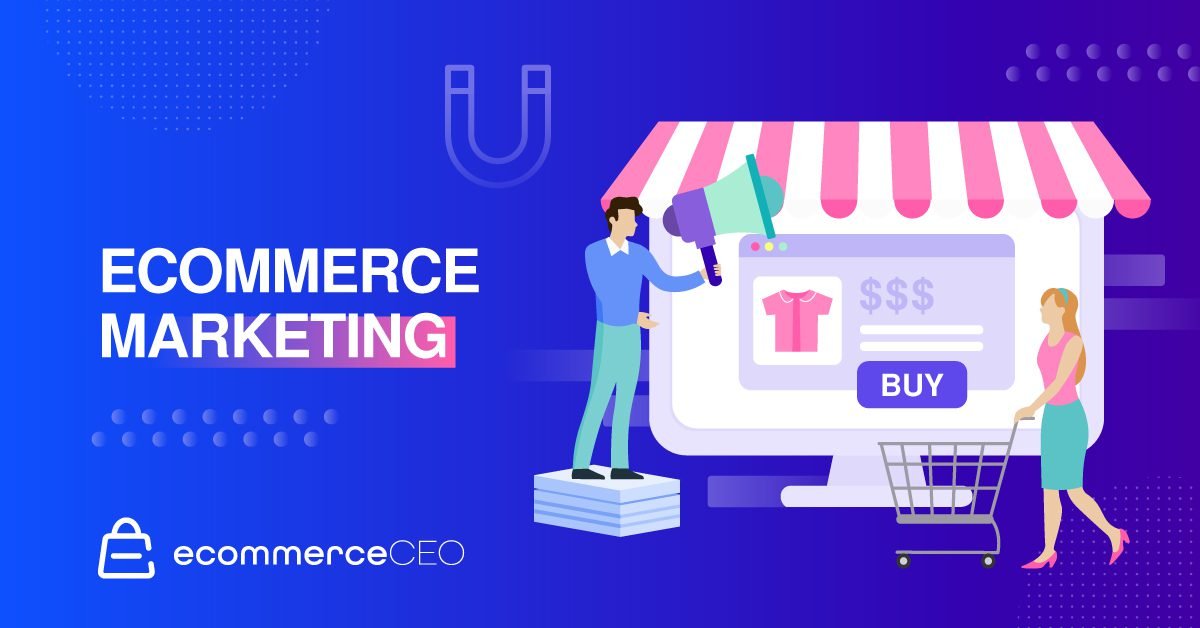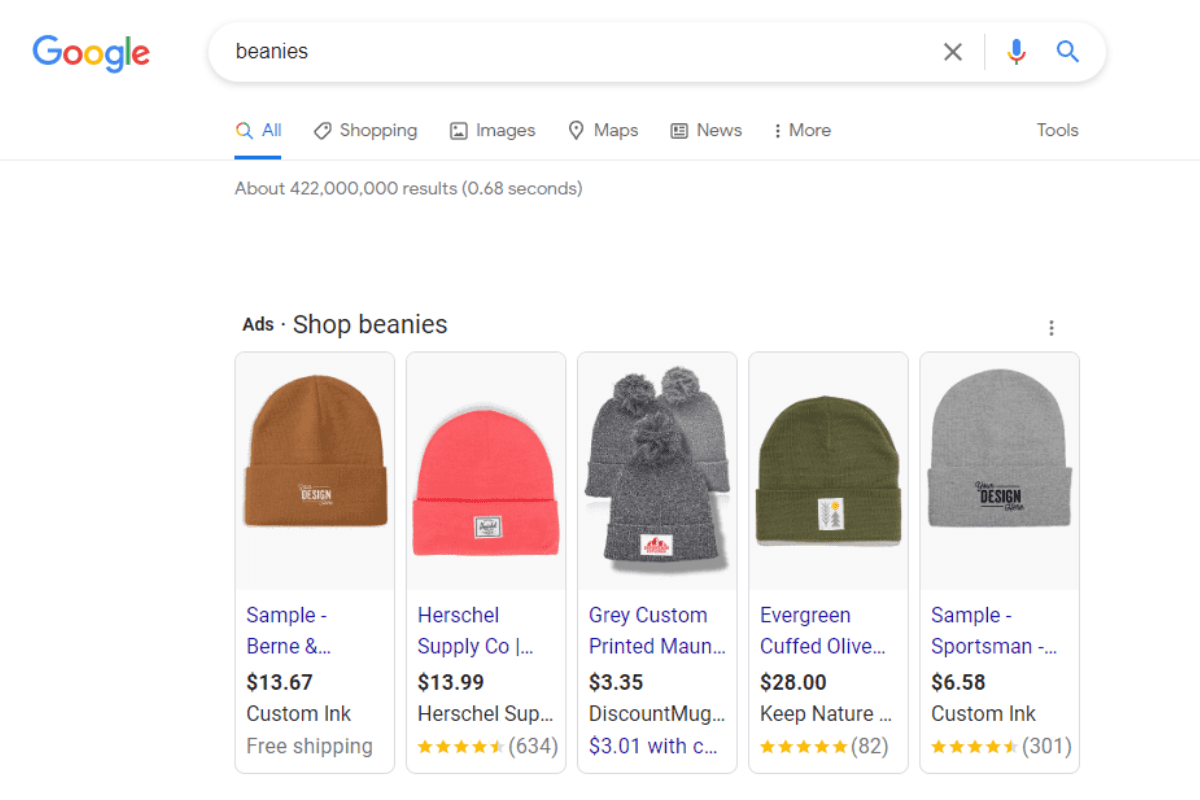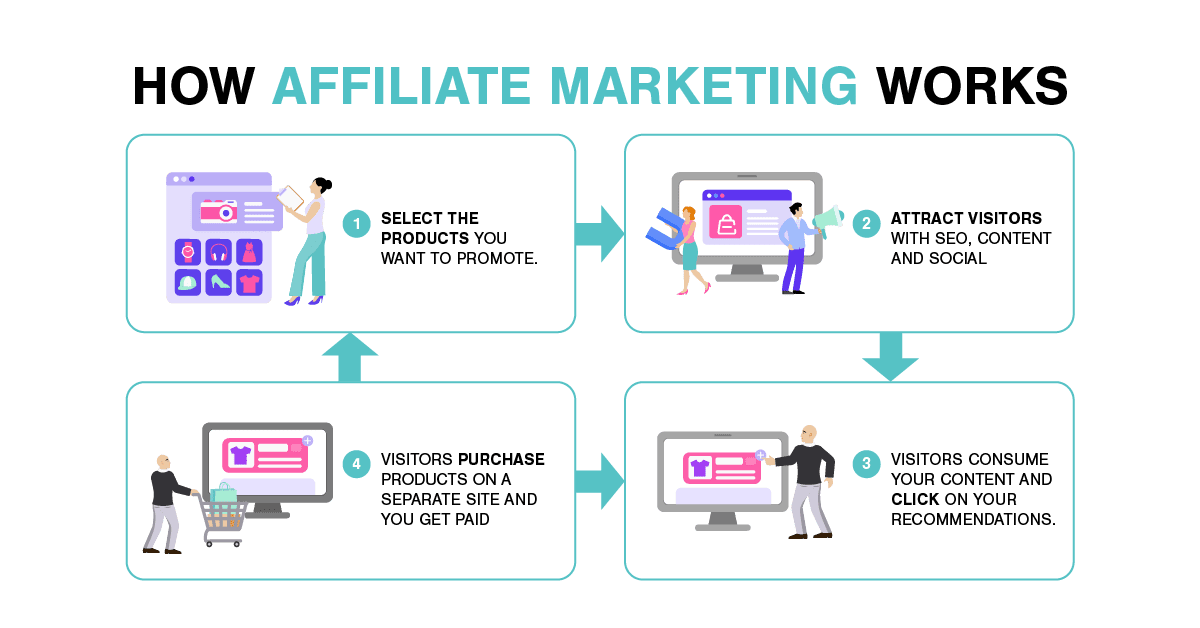If you want to be a business owner or retailer in the ecommerce biz, then having an understanding of ecommerce marketing is a must.
It’s not enough to just build a pretty ecommerce store, although that will help. You have to put in the time and work to make your brand known. Or you have to hire a marketing agency. So, if you want to get the scoop on ecommerce marketing, so you can better advertise your ecommerce site, keep reading.

Ecommerce Marketing Defined
There are three main phases of ecommerce marketing: planning, execution, and follow-up. In other words:
- Driving traffic to your site
- Converting that traffic into sales
- Retaining those customers for the future
Types of Ecommerce Marketing
That isn’t to downplay the importance of driving traffic to your site. Especially for new or growing ecommerce companies, new customers are the building blocks you need to succeed. Below are some tactics you can use to drive new traffic to your site, turn them into customers, and keep them coming back.
Email marketing
Email marketing is a key strategy for building a customer base and maintaining contact with them. Building an email list is one of the best early strategies for ecommerce companies. Why? Because it is a versatile medium for communicating, and email addresses are easy to collect and manage.
You can use email to send new customer offers, advertise sales, or welcome old customers back. You can promote products with text, images, or even videos. Customers can opt in for communications they do want and opt out of the types they don’t. Email is an excellent tool for targeted, effective ecommerce marketing, as long as you stay out of spam folders.
SMS marketing
SMS marketing owes part of its effectiveness to be underused. Most people check their text messages much more often than their email throughout the day, giving you a better chance of getting in front of your customers’ eyes.
You also need to be careful, though, because unless they give their express permission, sending marketing texts may seem like an invasion of privacy to some. Make it clear if you will use the phone numbers provided this way, and use this tactic sparingly.
PPC advertising
The main benefit of PPC advertising is that you aren’t throwing money into the wind and hoping for results. Unlike many other forms of online advertising, the Pay-Per-Click model has guaranteed benefits. In other words, you are paying for each visitor, not paying and hoping for visitors.
Google and Facebook are the most popular for PPC advertising campaigns. Google Shopping ads are most used by ecommerce brands. You’ll see these ads when you search for a specific product in Google and the search engine shows you an array of similar products available in your area (or for shipping). Google Shopping works well with Google Ads.

While it is up to you to turn that visitor into a conversion, at least you are buying that chance. Traditional paid search ads can be frustrating when you spend your finite marketing budget for ad space, only to get nothing in return. A good PPC strategy (such as retargeting) gives you a more predictable ROI making them a stable option for driving new traffic.
Search engine optimization
SEO should be a major focus for any ecommerce marketing strategy. While it may not deliver the fastest results, an investment of time now will pay dividends down the road.
Understanding search engine marketing best practices will improve your SERP visibility earning you more organic traffic. Tricks as simple as using image alt tags, having a linking strategy, and targeting the right keywords for Google search can bring new visitors to your site every day for free.
Content marketing
Content marketing is a vehicle for creating SEO opportunities and attracting organic traffic. The goal of content marketing is to land search users with target keywords, helpful information, and backlinking. The goal is to create a funnel that drives users to your site, converts them into customers, and increases retention.
Affiliate marketing
Affiliate marketing is similar to partnering with freelance salespeople. The job of an affiliate marketer is to promote your goods or services and drive sales.

This is often done through social media or affiliate websites. Simply put, an affiliate earns a commission for each conversion from their specific affiliate link.
The affiliate will promote your products or services through their marketing channels using specific links. When a customer clicks on that link and goes on to make a purchase, the affiliate gets credit, and you pay them a commission. This is a great way to boost visibility and ecommerce sales with predictable ROI.
Social media marketing
The landscape of the marketing industry has changed. Traditional methods like TV commercials and print ads are quickly being abandoned in favor of digital marketing, especially social media marketing.
Why? Because businesses need to go where their potential customers are. And where are they? Increasingly consumers are spending more and more time on social media platforms like Facebook, Instagram, YouTube, and TikTok.
Not only are more marketing budgets going toward social media marketing, but those investments tend to go further. For relatively small amounts, you can publish paid ads on just about any social platform. Another option is to create your own ads and content to share on your business page. Well-crafted social media posts can earn you tons of likes, shares, and comments, driving business to your site.
If your ecommerce business doesn’t already have a social media presence, you should strongly consider it.
Influencer marketing
Social media influencers tend to make great affiliates as they have a large, active audience. A single post promoting one of your products could lead to loads of sales, earning them a hefty commission and you a slew of new customers.
Another option is to skip the commission model and simply pay an influencer to make a sponsored post. Whenever possible, select an influencer who shares a similar target audience or has some relevance to your brand.
Ecommerce Marketing Ideas to Increase Sales and Drive Traffic
Now that you understand the different types of ecommerce marketing, it is time to develop some actual tactics you can use to boost traffic and sales. Below are the top proven methods.
1. Define your target audience and market
Before you get started, understanding your target audience can help you create focused and effective marketing material. Your target audience should include things like:
- Demographics (age, sex, location)
- Interests
- Goals
- Challenges

2. Invest in SEO
The sooner you invest in SEO, the longer you can reap the benefits of increased organic traffic.
Investing in SEO can mean educating yourself about best practices that you can use to improve your search visibility, utilizing software that can help optimize you for search, or even hiring an SEO pro to audit your site.
There are some simple SEO tips you can use to rank better in search engine results and capture more search traffic. While there are professionals who can help you, it is highly recommended that you educate yourself on SEO best practices to keep your site well-optimized into the future.
3. Run an influencer marketing campaign
Leveraging influencers can get you a lot of traction fast. This is an excellent tactic for new ecommerce companies or any business needing a quick boost. You essentially get what you pay for, so be strategic about who you partner with and be prepared to negotiate a fair deal.
If you don’t know where to begin, hop over to your business’s preferred social media platform and explore influencers related to your field. When you find someone with a similar target audience who shares your values, reach out to them with your offer.
4. Sell on marketplaces
While you will have to jump through more hoops and pay fees to do business on marketplace sites, gaining access to a pool of active users can be well worth it. This is an excellent tactic for up-and-coming ecommerce businesses that haven’t established their own customer base yet.
Create a merchant account on a platform (like Amazon or Facebook) that suits your products and use this shortcut to start making online sales. Be sure to include promotional material and branding in each package you send out, directing buyers to your website and socials. The goal is to leverage the reach of the marketplace to connect with potential customers, then bring them over to your side of the fence where they will visit your site directly in the future.

If they need a little extra push to leave the marketplace behind, use discount codes or exclusive offers to entice them to shop with you directly. Getting them to connect on social media is also a good way to stay in touch and hopefully break into their social circle where there may be others with similar interests.
5. Run PPC campaigns
With the predictable ROI of pay-per-click advertising, you can set up a campaign and let it run without much interference on your part. Set up an arrangement with an agreeable rate, and you’ll simply pay that much for each click. If you aren’t getting your money’s worth out of those clicks, you need to look at your conversion funnel to find out why those visitors aren’t becoming customers.
6. Upsell your products
Sometimes conversion rates aren’t the issue. You may be driving new traffic to your site, converting a healthy percentage of them, but still lagging behind in profitability. This means your funnel is working, but your pricing or average order size is too low.
You’ve already solved the most difficult parts of the puzzle: driving and converting traffic. You should now focus on increasing the average order size for those conversions.
To do this, you need to upsell or cross-sell. Some common tactics you can use to increase your average order size are:
- Offering package deals
- Bulk order discount offers
- Adding a “you may also like” carousel
- A free shipping threshold
- Strategic product placement
With these tactics, you can benefit more from each hard-fought conversion. You could even consider lowering your prices in hopes that higher average order sizes will compensate for slightly lower margins per item.
7. Integrate Instagram
Instagram is becoming more and more essential for ecommerce businesses. There are over 200 million business accounts on Instagram, so if you aren’t keeping up, you could get left behind.
According to a recent survey, roughly half of Instagram users discovered new brands on the platform. This makes Instagram a golden opportunity to grow brand awareness and drive traffic to your site.
The new Instagram Shopping feature even allows you to create shoppable posts so you can sell to your Instagram followers without them leaving the app!

8. Reduce abandoned carts
Cart abandonment means you were close to succeeding with your sales funnel but came just short of the finish line. You were able to get a website visitor, they found something they were interested in, but didn’t follow through with the purchase.
You should begin by asking yourself, “why?” What prevented the customer from checking out when they had already gone through the trouble of adding something to their shopping cart? Some common reasons include:
- The cart total was too high
- Shipping costs were unreasonable
- The checkout process took too long
- They are worried about their personal information
- A coupon code or special offer didn’t work
Sometimes shoppers get cold feet or are interrupted and don’t complete their purchase. One strategy is sending an abandoned cart email reminding visitors to complete their purchase or even offering a coupon.
9. Send text message campaigns
Text message marketing is an underutilized tactic, which is part of what makes it effective. Consumers are used to their email being flooded with marketing messages, making them more likely to skim over yours.
SMS messages are more likely to be acknowledged and hopefully get the customer thinking about your brand. Just be careful not to abuse personal information by sending unwarranted or excessive text messages. This can be a quick way to lose a customer’s trust.
10. Improve your email campaigns
Email marketing campaigns are the backbone of many marketing strategies. This tactic offers a lot of flexibility, meaning there are a lot of ways you can improve yours.
You should be measuring the success of your email marketing with stats like opens, clickthrough rates, and conversions to gain insight into your ecommerce strategy. Are your current customers opening your email at all? Are they clicking through to your website? Is your funnel driving them all the way to making a purchase?

Identifying weak points allows you to focus on improving those areas by trying different strategies that can increase your success.
11. Consider Content Marketing
Like SEO, digital content marketing is a long-term investment. Consider an article that you write for your site that brings in only 50 visitors a month. Fifty visitors may not seem worth the marketing effort, but it adds up when you consider that recurring traffic every month.
Over the course of a year, that’s 600 visitors from a single article. Over five years? 3,000. Now imagine you write ten articles or a strong article that brings in ten times as much traffic. Suddenly you have 6,000 new visitors a year just from inbound marketing.
It takes an investment of time or money to begin a content marketing campaign, but the sooner you do, the sooner those articles will start bringing you traffic.
12. Think local
While one of the most significant advantages of ecommerce is global reach, there are still some advantages to local campaigns. Your local community is the best opportunity for a grassroots campaign and can help you grow your customer base early on.
Before you have a strong search or social presence, it can be a challenge to gain traction on the World Wide Web. There is much less competition in your local market, so you can start there to build a strong foundation.
There are countless ways to market your company locally, with both online and offline marketing. Consider joining or sponsoring local social media groups, doing giveaways, or purchasing a spot at a street fair; anything to familiarize people with your brand!
13. Optimize your product pages
Optimizing product pages can improve both SEO and conversions. Optimizing metadata and keywords can help drive more traffic to your site, while a better user experience can increase conversions.
Audit your product pages to see which aspects are most in need of an upgrade. You can check analytics data to see the conversion rates for different pages and shore up weak elements to get more sales and visits.
A great place to start is the image and product description for each item.
14. Reward loyal customers
Incentivizing repeat business can be a very efficient way to boost site traffic and sales. Since these customers have bought from you in the past, they have already completed the first two phases of your sales funnel. All that is left is to keep them shopping.
One way to do this is with customer loyalty programs. Setting up loyalty rewards can be a bit of work, but the initial investment increases the chances of repeat business and referrals. Even a simple coupon or giveaway for past customers can be enough to get them back to your shop for another round of online shopping.
15. Implement live chat support
Having a good customer support system will make your business more likeable. Live chat support won’t help drive new traffic to your site, but it can help conversions for visitors already there.
Many of your shoppers will have questions about products or services they buy online. This can be as simple as helping navigate your website or specific questions about a product.
Live support can help the customer experience and improve buyer confidence. While implementing chat support can be a significant investment, increasing conversions may be worth it.
16. Set up a blog
A blog is a vehicle for content marketing. It allows you to easily publish content that is relevant to your website. This content can be hosted on your site itself or a separate entity you use for backlinking. Ecommerce platforms like Shopify, Wix, and Squarespace allow you to set up a blog along with your online store.
The tactic here is to write informative or entertaining blog posts related to your niche. Product reviews, guides, and stories can all work well. The goal is to use keywords your target customers are searching for to get them to click on your blog. Then, you can advertise your brand or direct them to shop on your site. If a blog doesn’t sound appealing to you, consider setting up a podcast instead – or do both!
17. Research marketing tools
Research marketing tools can help you sharpen the focus of your efforts with valuable data that can help your strategy. Using research marketing insight, you can cut out a lot of the guesswork and build a strategy around the data.
Knowing what your target audience is searching for, where they are most engaged on social media, or even just their demographics can be a big help when planning a marketing campaign.
Executing Your Ecommerce Marketing Plan
Once you’ve decided on some new marketing channels to pursue and tactics to implement, it is time to execute your plan. Consider the goals you want to achieve and the steps it will take to make that happen. Below are some examples.
1. Form a Sales and Lead Generation Strategy
To grow your business, you need to generate new leads and sales. As you saw in the tips above, there are many ways to achieve either of these objectives.
A sales funnel represents the steps needed to generate leads and turn those leads into sales. It is a continuous process of improvement, often through trial and error. An outdated ecommerce strategy is doomed to fail.
Understand your market and audience, and don’t be afraid to try new things. New tactics can allow you to reach new audiences, which may be just what you need for continued growth.
2. Invest in Technology and Reporting Software
Any business plan can benefit from analytics. Learning more about your visitors and behavior on your site can help you pinpoint your strengths and weak areas in need of improvement.
There are also countless tools designed to improve efficiency in ecommerce. Examples include:
- Marketing automation
- Email automation
- Web page builders
- CRMs
- SEO tools
- Analytics suites
- … and countless others
With all of the helpful software available for ecommerce businesses, there are surely ways you can work smarter, not harder.
3. Focus on Conversions
It’s hard to see the end goal when it comes to ecommerce marketing. Reaching new people and driving traffic to your site has little value if those visitors aren’t converting.
Especially if your site already has healthy paid or organic traffic, it may be more effective to switch your focus to conversion rate optimization so more of your visitors become paying customers.
4. Try Out New Strategies
If you feel like you’re in a rut and having trouble achieving that next milestone on your ecommerce journey, it may be time to try some new strategies.
The above ecommerce marketing tips offer a wide variety of proven tactics that you can use to boost traffic and conversions on your site. While you are likely already employing several of these methods, there are almost certainly some you haven’t tried or can stand to improve.
One of these tips could help you break into fresh markets and drive entirely new audiences to your site.
5. Perfect and Grow Your Ecommerce Marketing Strategy
Ecommerce is an ever-changing game. Much has changed even in the last few years since the COVID-19 pandemic. For your business to continue to grow, your marketing strategy needs to grow too.
Complacency gives your competition the chance to catch up and steal your traffic. The only way to stay ahead is to continue perfecting your marketing tactics and trying other strategies that will drive new traffic to your site.
From there, it is up to you to turn those visitors into paying customers and keep them coming back to shop on your site.
Ecommerce Marketing FAQs
Start Marketing Your Ecommerce Business Today
Every small business or online retailer needs to think about its marketing. With so many different strategies for marketing your ecommerce business, there are surely some you haven’t tried. While not every strategy will apply to your ecommerce website or be easy to implement, I hope some of them have inspired you to try new tactics that will boost your business’ success.









